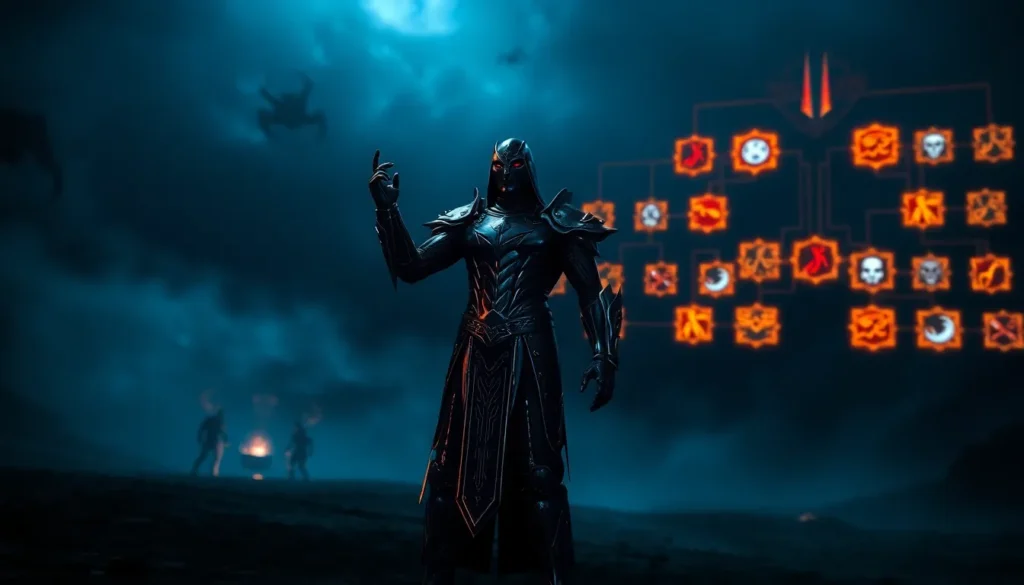In the dark and twisted world of Diablo 4, dealing damage isn’t just about swinging a sword or casting a spell. It’s about crafting a strategy that leaves foes trembling in their boots long after the initial blow. Enter the realm of Damage Over Time (DoT) effects—a sneaky little trick that turns battles into a slow-burning nightmare for enemies.
Table of Contents
ToggleOverview of Damage Over Time Mechanics
Damage Over Time (DoT) mechanics play a crucial role in Diablo 4’s combat system. DoT effects inflict damage gradually rather than instantly, allowing for sustained pressure on enemies. Various abilities, such as poison or burn effects, enable players to chip away at health over time, creating strategic advantages in battles.
Each class utilizes DoT differently. For example, the Sorceress can cast abilities that leave lingering ice or fire effects, continually damaging opponents. Similarly, the Druid’s poison skills can sap the strength of foes while the class uses nature-based tactics to maintain pressure.
Understanding damage types is vital. Poison damage continues for a specific duration, while bleed effects hemorrhage health over time. Choosing the right skills enhances a player’s effectiveness in combat, leading to successful encounters against tough adversaries.
Managing resources remains essential. Players need to balance their resource usage with the duration of DoT effects. Effective cooldown management allows for more frequent application of damage over time skills, maximizing total damage output.
In multiplayer scenarios, teamwork enhances DoT effectiveness. Coordinating with teammates to apply multiple DoT effects on a single enemy can overwhelm bosses or powerful foes, creating opportunities for victory. Team synergy amplifies the impact of each player’s abilities.
Ultimately, mastering DoT mechanics contributes significantly to a player’s overall effectiveness in Diablo 4. By employing strategic DoT skills, players can dominate in encounters, turning battles into strategic exercises rather than mere skirmishes.
Types of Damage Over Time Effects
Damage Over Time (DoT) effects in Diablo 4 come in various types, each with unique characteristics and strategic advantages. Understanding these effects helps players optimize their combat strategies.
Poison Damage
Poison damage inflicts gradual damage over time, primarily impacting health. This type of damage can be particularly effective in wearing down resilient enemies. Characters like the Druid utilize poison skills to weaken foes and apply pressure without needing to stay in close range. By combining poison with other abilities, players can enhance their overall damage output. Notably, enemies affected by poison may suffer additional debuffs, enhancing the effectiveness of follow-up attacks. Timing the application of poison skills is crucial, as maintaining this effect can significantly shift the tide of battle.
Bleed Damage
Bleed damage works by causing enemies to lose health continuously over time, simulating the effects of deep wounds. Characters like the Barbarian excel at inflicting bleed effects with weapon attacks. Stacking multiple bleed effects on a single target can overwhelm their defenses, especially against tough bosses. Using skills that amplify bleed damage creates opportunities for more significant bursts of damage. Effective management of bleed effects is critical, as precise timing and strategic application can make the difference between victory and defeat in intense encounters.
Fire Damage
Fire damage burns foes over time, applying a damaging effect that enhances overall combat efficiency. The Sorceress excels in using fire spells that not only deal immediate damage but also leave lingering fire effects. Enemies affected by fire damage may suffer from additional ignited effects, leading to even larger damage outputs. Coordinating fire attacks with allies can create devastating combos in multiplayer scenarios. Players can leverage fire damage to control crowd dynamics, pushing enemies back while steadily depleting their health. Handling fire skills with precision maximizes their impact during critical moments in battle.
Best Classes for Damage Over Time
Classes in Diablo 4 excel at inflicting Damage Over Time (DoT) effects. Each class utilizes this mechanic in distinct ways, enhancing overall gameplay.
Necromancer
Necromancers thrive on DoT through skills that summon minions and manipulate the life force of enemies. The Blood skill tree specializes in abilities like Blood Lance, which inflicts damage over time while healing the player. Additionally, Decrepify slows enemies, making them more susceptible to DoT effects. Summoning skills can create golems that apply poison damage, continuously sapping enemy health. Mastering these abilities positions the Necromancer as a formidable DoT class.
Druid
Druids effectively employ a variety of elemental DoT effects. Utilizing the Poison and Storm skill trees, they can transform the battlefield with spells like Vine Creeper, leaving trails of poison that damage enemies over time. Skills such as Tornado can deal damage repeatedly, enhancing the Druid’s ability to exert pressure during combat. By combining various elemental skills, Druids maintain significant control and adaptability, making them efficient in prolonged encounters.
Rogue
Rogues incorporate DoT mechanics into their agile combat style. Skills in the Shadow tree, such as Poison Trap, deliver consistent damage while immobilizing targets. The Bleed effect, achieved through skills like Flurry, ensures continuous health decline in affected enemies. By leveraging mobility and stealth, Rogues can swiftly apply DoT effects and evade harm, allowing for strategic play. Their versatility makes them a noteworthy choice for players focusing on damage over time.
Strategies to Maximize Damage Over Time
Mastering Damage Over Time (DoT) mechanics requires a strategic approach involving skill synergies and targeted gear choices.
Skill Synergies
Connecting skills enhances overall DoT output. Players often find value in creating combinations that amplify damage effects. For instance, stacking bleed skills with crit damage bonuses maximizes health drain on enemies. Wizards benefit from pairing fire damage abilities with frost skills to control enemy movement while dealing damage. Each class presents unique opportunities for synergies, leading to higher damage potential. Experimentation plays a crucial role, allowing players to discover effective combinations tailored to their gameplay style.
Gear and Itemization
Selecting the right gear significantly impacts DoT effectiveness. Certain items provide bonuses, such as increased DoT duration or enhanced damage for specific types. For example, a pair of gloves may boost fire damage effects, while a necklace could enhance poison skills. Prioritizing gear that complements a chosen build focuses on maximizing the lasting impact of attacks. Players should also consider legendary items offering unique attributes that synergize with DoT strategies. Proper itemization creates a robust framework for sustained damage output, allowing characters to dominate in combat scenarios.
Conclusion
Mastering Damage Over Time mechanics in Diablo 4 is essential for players looking to enhance their combat effectiveness. By strategically applying various DoT effects, they can transform encounters into prolonged battles that require careful planning and execution.
Each class brings unique strengths to DoT strategies, allowing for diverse gameplay experiences. Whether utilizing poison, bleed, or fire damage, players can create powerful synergies that elevate their damage output.
Effective resource management and gear selection further amplify DoT capabilities, enabling players to dominate their foes. Embracing these strategies not only improves individual performance but also fosters teamwork in multiplayer scenarios, making every battle a strategic challenge.






